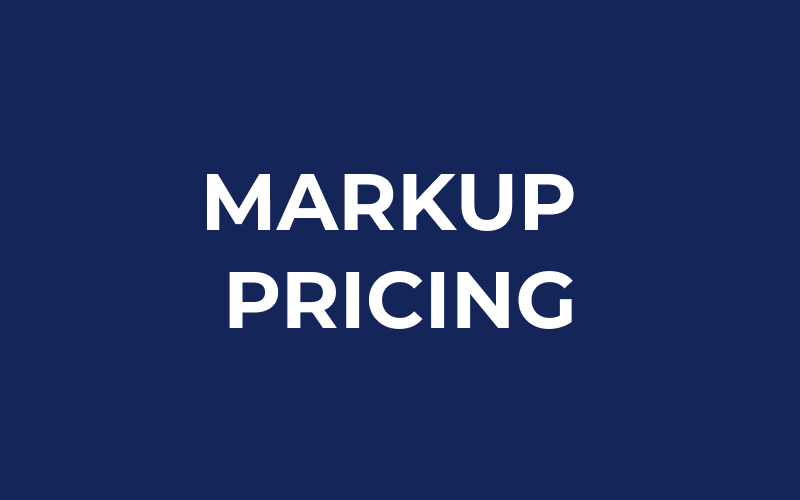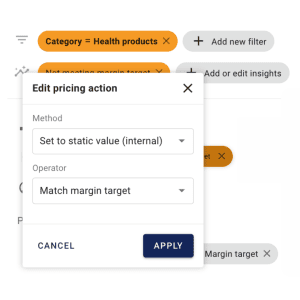
Markup pricing
Is a pricing strategy that involves taking the cost of a product and adding a certain percentage on top of it to set the final selling price for a product. This method is used by many businesses as it provides a straightforward and predictable way of setting prices, and helps to cover costs and generate profit.
When using markup pricing, it’s important to carefully consider the costs of production, including materials, labor, and overhead, to ensure that the markup is sufficient to cover these expenses and generate a profit. Businesses may also need to consider the competition, market trends, and customer demand to determine the right markup percentage.
Take your pricing strategy to the next level
Supercharge your pricing strategy with Sniffie! Set products to meet your margin targets effortlessly. Our intuitive platform lets you customize and optimize your pricing strategy with precision. Don’t just stay competitive; stay ahead of the game with Sniffie.

Markup pricing in ecommerce and retail
In ecommerce, businesses can use technology and data analysis to help with their markup pricing strategy. For example, they can use software to analyze sales data and adjust markup percentages based on market trends and customer behavior. Additionally, they can use online tools to monitor competitor pricing and adjust their own prices accordingly.
The pricing strategy can be an effective for businesses of all sizes, but it is especially useful for small and medium-sized enterprises that need a simple and straightforward way of setting prices. This method also allows businesses to easily adjust prices based on changes in the market and customer demand.
In ecommerce and retail businesses, markup pricing can impact pricing in the following ways:
Determining profitability: Markup pricing helps businesses determine the profitability of a product by calculating the markup percentage and setting a selling price that will cover costs and generate a profit.
Pricing competitively: Businesses can use markup pricing to price products competitively by comparing the markup percentage to that of their competitors.
Setting prices for different product lines: Businesses can use markup pricing to set prices for different product lines by applying different markup percentages to different types of products.
Adjusting prices over time: Businesses can use markup pricing to adjust prices over time based on changes in the cost of the product or changes in the market.
Setting prices for different sales channels: Businesses can use markup pricing to set different prices for different sales channels, such as retail stores and online marketplaces, by applying different markup percentages.
Summary
Markup pricing is a widely used strategy in retail and ecommerce businesses for determining prices by adding a percentage to the cost of a product. By carefully considering costs and market factors, businesses can use this method to set prices that cover costs and generate profit.
FAQ
Most frequent questions and answers
Markup pricing is a pricing method where a fixed percentage, known as the markup, is added to the cost of a product to determine its selling price. The markup covers the overheads and contributes to the profit of the business. This is one of the most straightforward and commonly used pricing strategies, especially in retail and manufacturing businesses.
Markup pricing involves calculating the cost of the product and then adding a predetermined percentage to arrive at the selling price.
For example, let’s say a shoe retailer buys shoes from a manufacturer for $50 a pair. The retailer decides on a markup of 60%. The markup price in dollar terms will be $50 * 60/100 = $30. So, the selling price of the shoes will be $50 (cost price) + $30 (markup) = $80.
Here are the steps to calculate markup pricing:
Determine the Cost: The first step is to accurately calculate the cost of the product. This can include the cost of raw materials, labor, and other direct production costs.
Set the Markup Percentage: Decide on the markup percentage. This should cover your overhead costs (like rent, utilities, salaries) and also provide a profit margin.
Calculate the Markup Price: Multiply the cost of the product by the markup percentage to get the markup in dollar terms.
Determine the Selling Price: Add the markup to the cost of the product. The result is your selling price.
Markup pricing has several benefits:
Simplicity: It’s a simple and straightforward method that doesn’t require detailed market research or complex calculations.
Ensures Profitability: Since the markup includes a profit margin, every sale contributes to the profitability of the business.
Covers Costs: The markup is designed to cover both the cost of the product and overheads, reducing the risk of losses.
Flexibility: Markups can be easily adjusted to accommodate changes in costs or to react to market conditions.
However, it’s important to remember that markup pricing doesn’t take into account competition, customer’s willingness to pay, or market demand, which could result in pricing that’s too high or too low. Therefore, it’s crucial to consider these factors alongside the use of markup pricing.

